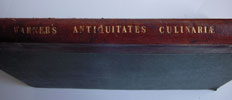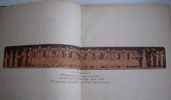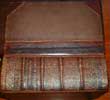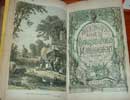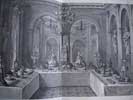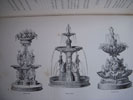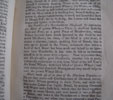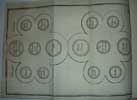THE UNIVERSAL COOK,
AND City and Country Housekeeper. CONTAINING ALL THE VARIOUS BRANCHES OF COOKERY: THE DIFFERENT METHODS OF DRESSING Butchers Meat, Poultry, Game, and Fish; AND OF PREPARING GRAVIES, CULLICES, SOUPS, AND BROTHS; TO DRESS ROOTS AND VEGETABLES, AND TO PREPARE Little elegant Dishes for Supper or light Repasts: TO MAKE ALL SORTS OF PIES. PUDDINGS, PANCAKES, AND FRITTERS; CAKES, PUFFS, AND BISCUITS; CHEESECAKES, TARTS, AND CUSTARDS; CREAMS AND JAMS; BLANC MANGE, FLUMMERY, ELEGANT ORNAMENTS, JELLIES, AND SYLLABUBS. The various Articles in CANDYING, DRYING, PRESERVING, AND PICKLING. THE PREPARATION OF HAMS, TONGUES, BACON, &C. DIRECTIONS FOR TRUSSING POULTRY, CARVING, AND MARKETING. THE MAKING AND MANAGEMENT OF Made Wines, Cordial Waters, and Malt Liquors. Together with Directions for Baking Bread, the Management of Poultry and the Dairy, and the Kitchens and Fruit Garden; with a Catalogue of the Various articles in Season in the different Months of the Year. Besides a Variety of USEFUL AND INTERESTING TABLES. The Whole Embellished with The Heads of the Authors, Bills of Fare for every Month in the Year, and proper Subjets for the Improvement of the Art of Carving, elegantly engraved on fourteen Copper-Plates. By FRANCIS COLLINGWOOD, AND JOHN WOOLLAMS. Principal Cooks at the Crown and Anchor Tavern in the Strand, Late from the London Tavern. LONDON: PRINTED BY R. NOBLE, FOR J. SCATCHERD AND J. WHITAKER, NO. 12, AVE-MARIA-LANE. 1792.
FIRST EDITION. 8vo. 2feps with 2 previous owners signatures. Half title. [2] Frontispiece of both authors. Title page. [1] 2p. Preface. 20p Contents. 12 engraved plates of bills of fare for every month, with each verso blank. (curiously they have been bound in out of monthly order. All are present). (1)2-432. 433-444 A Catalogue of seasonal articles. 445-451 Marketing Tables. 2feps. Original full dark calf covered boards with blind tooled lines on the boards. The spine with blind tooled lines. With a dark red label and gilt lettering. Overall has a nice patina. Besides very light age browning to frontispiece and plates , the text block is very clean. Overall, a nice copy.
- F. Collingwood and J. Woollams were the Principal cooks at the Crown and Anchor Tavern on the south side of the Strand, London WC1. Strype the historian informs us, that in 1729 an original tavern called the Crown occupied the same site. The Anchor was added to the name shortly after that date, in honour of St Clements Church nearby; an anchor being the emblem of the patron saint who suffered his martyrdom by being cast into the sea with an anchor tied to his neck. The site began a few doors down Arundel St. and extended to Milford Lane. It had an entrance from the Strand thro’ a narrow courtyard. The tavern was very famous and very well frequented by the rich, famous and important members of English high society. Dr Johnson made it his second home. Taking his daily walks with his friend Boswell past Temple Bar, going westward, the Crown and Anchor was their port of call and also of many of their confreres. It was here that Dr Jonson’s famous spat with Percy took place. The Academy of Music was first started at the Tavern. The house was pulled down in 1790 and rebuilt. A very large banqueting room was erected, measuring 85x36 feet, and when packed could hold 2500 guests. It was first opened on the occasion of a birthday dinner given to Charles James Fox, M.P. and presided over by the Duke of Norfolk. The room was used for fine balls and political meetings of both the Tories and radical Parties; anyone in fact who could pay the high prices. The Tavern became the headquarters of one party or another during the Westminster parliamentary elections. It is recorded that Daniel O’Conner M.P., Brougham Cobbet, Sir Francis Burdett and others, held meetings that always crowded the room. After the 1790 rebuild, the first landlord was a famous, very large obese man; Thomas Simkin. He famously died by leaning on the upstairs banister, and calling down some instructions, the banister gave way under his huge weight and he toppled to his death below. The Tavern had elegant booths opened for their customers at the courses during the racing season and the main fairs. As well as refreshments they also held dances. Sadly, in 1854 the Tavern burned down. Afterwards the Duke of Norfolk built Arundel House on the site and further afield. This great Tavern is the establishment where Collingwood and Woollams established their substantial reputation. They had the unique distinction of having this first edition of 1792; ‘The Universal Cook’, being translated into French and sold in France. Published in Paris in 1810 it was re-named ‘ Le Cuisinier Anglais Universal ou le Nec Plus Ultra de la Gourmandise’. This was the time of the war with Napoleon, but the reputation of London food and its Cooks stood high with foreigners. This book is a record of professional 18th century English gastronomy, as opposed to the cookery books written for the housewife. As can be read on the title page, it has extensive instructions for all the tasks undertaken in such an important Tavern and its Kitchen. The equally rare second edition was published in 1797 with very little change; see item ref #: 11131. See also, item ref #: 11035 for a rare dinner invitation to the Crown and Anchor Tavern when Collingwood and Woolllams were the head cooks.

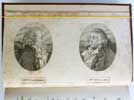




click on image to enlarge

Antiquarian category
ref number:
11227 





